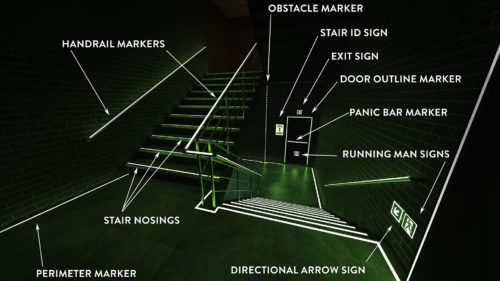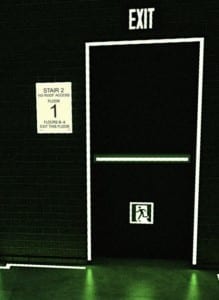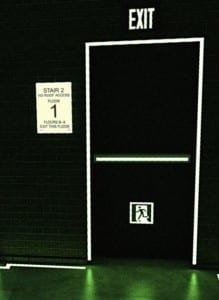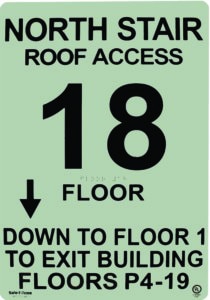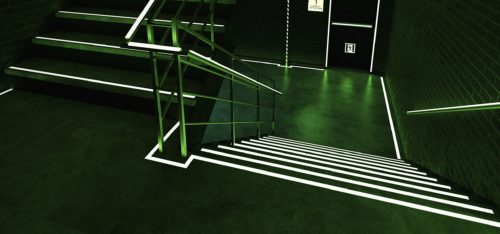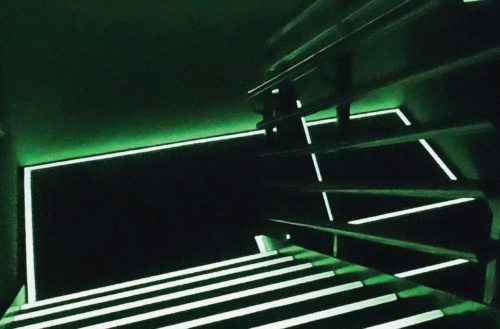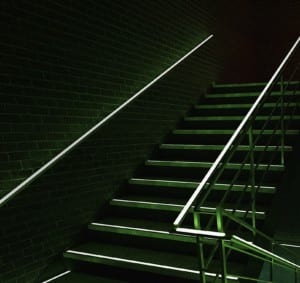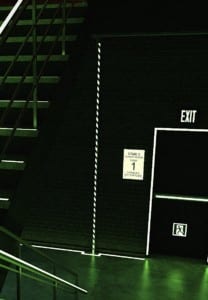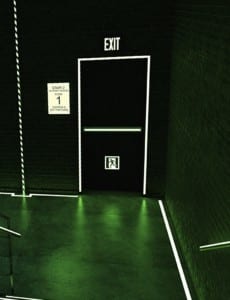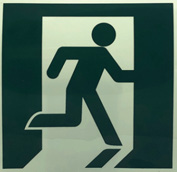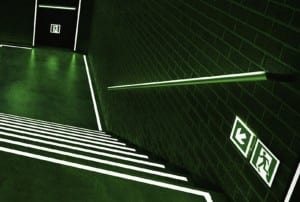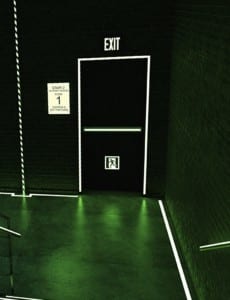INTERNATIONAL BUILDING CODE (I.B.C.) AND INTERNATIONAL FIRE CODE (I.F.C.)
1013.1 Exit Signs/Where Required
Exits and exit access doors shall be marked by an approved exit signs readily visible from any direction of egress travel. The path of egress travel to exits and within exits shall be marked by readily visible exit signs where the exit or path of egress travel is not immediately visible to occupants. Intervening means of egress doors within exits shall be marked by exit signs. Exit sign placement shall be such that no point in an exit access corridor or exit passageways is more than 100 feet or the listed viewing distance of the sign, whichever is less, from the nearest visible exit sign.
1013.2 Low-Level Exit Signs in Group R-1
Where exit signs are required in Group R-1 occupancies by Section 1013.1, additional low-level exit signs shall be provided in all areas serving guest rooms in Group R-1 occupancies and shall comply with Section 1013.5. The bottom of the sign shall not be less than 10 inches and no more than 18 inches above the floor. The sign shall be flush mounted to the door or wall. Where mounted on the wall, the edge of the sign shall be within 4 inches of the door frame on the latch side.
1013.5 Internally Illuminated Exit Signs
Electrically powered, self-luminous, and photo-luminescent exit signs shall be listed and labeled in accordance with UL 924 and shall be installed in accordance with the manufacturer’s instructions and Chapter 27. Exit signs shall be illuminated at all times.
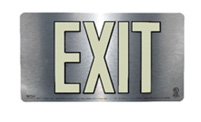
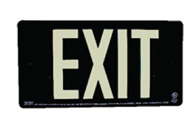
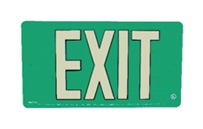
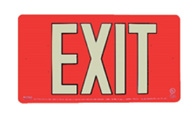
1023.9 Stairway Identification Signs
A sign shall be provided at each floor landing in an interior exit stairway and ramp connecting more than 3 stories designating the floor level, the terminus of the top and bottom of the interior exit stairway and ramp and the identification of the stairway and ramp. The signage shall also state the story of, and direction to, the exit discharge and the availability of roof access from the interior exit stairway and ramp for the fire department. The sign shall be located 5 feet above the floor landing in a position that is readily visible when the doors are in the open and closed position. In addition to the stairway identification sign, a floor level sign in visual characters, raised characters and braille complying with ICC A117.1 shall be located at each floor-level landing adjacent to the door leading from the interior exit stairway and ramp into the corridor to identify the floor level.
1023.9.1 Signage Requirements
Stairway identification signs shall comply with all of the following requirements: 1. The signs shall be a minimum size of 18 inches by 12 inches. 2. The letters designating the identification of the interior exit stairway and ramp shall be not less than 1 1/2 inches in height. 3. The number designating the floor level shall be no less than 5 inches in height and located in the center of the sign. 4. Other lettering and numbers shall be no less than 1 inch in height. 5. Characters and their background shall have a non-glare finish. Characters shall contrast with their background. 6. Where signs required by Section 1023.9 are installed in the interior exit stairway and ramps of buildings subject to Section 1025, the signs shall be made of the same materials as required by Section 1025.4.
1025.1 General Codes
Approved luminous egress path markings outlining the exit path shall be provided in high-rise buildings of Groups A, B, E, I, M or R-1 occupancies in accordance with this section. High-rise building: a building with occupied floor located more than 75 feet above the lowest level of fire department vehicle access.
1025.2.1 Steps
A solid and continuous stripe shall be applied to the horizontal leading edge of each step and shall extend for the length of the step. Outlining stripes shall have a minimum horizontal width of 1 inch and a maximum width of 2 inches. The leading edge of the stripe shall be placed not more than 1/2 inch from the leading edge of the step.
1025.2 Markings Within Exit Enclosures
Egress path markings shall be provided in interior exit stairways, interior exit ramps and exit passageways, in accordance with Sections 1025.2.1 through 1025.2.6
1025.2.2 Landings
The leading edge of landings shall be marked with a stripe consistent with the dimensional requirements for steps.
1025.2.3 Handrails
Handrails and handrail extensions shall be marked with a solid and continuous stripe having a minimum width of 1 inch. The stripe shall be placed on the top surface of the handrail for the entire length of the handrail, including extensions and newel post caps. Where handrails or handrail extensions bend or turn corners, the stripe shall not have a gap of more than 4 inches.
1025.2.4 Perimeter Demarcation Lines
Stair landings and other floor areas within interior exit stairways, interior exit ramps and exit passageways, with the exception of the sides of steps, shall be provided with solid and continuous demarcation lines on the floor or on the walls, or a combination of both. The stripes shall be 1 to 2 inches wide with interruptions not exceeding 4 inches.
1025.2.4.1 Floor-Mounted Demarcaton Lines
Perimeter demarcation lines shall be placed within 4 inches of the wall and extend to within 2 inches of the markings on the leading edge of landings. The demarcation lines shall continue across the floor in front of all doors.
1025.2.4.2 Wall-Mounted Demarcation Lines
Perimeter demarcation lines shall be placed on the wall with the bottom edge of the strips not more than 4 inches above the finished floor. At the top or bottom of thestairs, demarcation lines shall drop vertically to the floor within 2 inches of the step or landing edge. Demarcation lines on the wall shall transition vertically to the floor and then extend across the floor where a line on the floor is the only practical method of outlining the path. Where the wall line is broken by a door, demarcation lines on wall shall continue across the face of the door or transition the floor and extend across the floor in front of such door.
1025.2.4.3 Transition
Where a wall-mounted demarcation line transitions to a floor-mounted demarcation line, or vice versa, the wall-mounted demarcation line shall drop vertically to the floor to meet a complementary extension of the floor-mounted demarcation line, thus forming a continuous marking.
1025.2.4.5 Obstacles
Obstacles at or below 6’ 6” and projecting more than 4 inches into the egress path shall be outlined with markings no less than 1 inch in width, comprised of a pattern of alternating equal bands, of luminous material, and black, with the alternating bands no more than 2 inches thick and angles at 45 degrees. Obstacles shall include, but are not limited to, standpipes, hose cabinets, wall projections and restricted height areas. However, such markings shall not conceal any required information or indicators.
1025.2.4.6 Doors Within The Exit Path
Doors through which occupants must pass in order to complete the exit path shall be provided with markings complying with Sections 1025.2.6.1 through 1025.2.6.3.
1025.2.4.6.1 Emergency Exit Symbol
The doors shall be identified by a low-location luminous emergency exit symbol complying with NFPA 170. The exit symbol shall not be less than 4 inches in height and shall be mounted on the door, centered horizontally, with the top of the symbol no higher than 18 inches above the finished floor.
1025.2.4.6.2 Door Hardware Markings
Door hardware shall be marked with no less than 16 square inches of luminous material. The markings shall be located behind, immediatley adjacent to, or on the door handle or escutcheon. Where a panic bar is installed, such material shall be no less than 1 inch wide for the entire length of the actuating bar or touchpad.
1025.2.4.6.3 Door Frame Markings
The top and sides of the door frame shall be marked with a solid and continuous 1-inch to 2-inch wide stripe. Where the door moldings does not provide sufficient flat surface on which to locate the stripe, the stripe shall be permitted to be located on the wall surrounding the frame.
1025.3 Uniformity
Placement and dimensions of markings shall be consistent and uniform throughout the same exit enclosure.
1025.4 Self-Luminous and Photoluminsescent
Luminous egress path markings shall be permitted to be made of any material, including paint, provided that an electrical charge is not required to maintain the required luminance. Such materials shall include, but not limited to, self-luminous materials and photoluminous materials. Materials shall comply with either: 1. UL 1994; or 2. ASTM E 2072, except that the charging source shall be 1 foot candle of fluorescent illumination for 60 minutes, and the minimum luminance shall be 30 millicandelas per square meter at 10 minutes and 5 millicandelas per square meter after 90 minutes.
1025.5 Illumination
Where photoluminescent exit path markings are installed, they should be provided with not less than 1 footcandle of illumination for no less than 60 minutes prior to periods when the building is occupied and continuously during occupancy.
NYC
New York City models the national codes – I.B.C. / I.F.C.
New York City has been a leader in adoption of luminous egress path marking. In addition to the national model code, NYC requires additional signage, product labeling and a TR7 form filed stating all was completed to code requirements.
California
In addition to the adoption of the national model code, California enforces the ADA contrasting stripe 2″ to 4” top and bottom of each run of stairs.
They must be safety yellow if the stair is considered outside.
Sometimes the parking garage under the high rise would be considered exterior, and therefore safety yellow markings are required.
Las Vegas
In addition to adoption of the national model code, Las Vegas defines a high rise building as 55 feet above grade, the I.B.C. defines a high rise building as 75 feet above grade.
Los Angeles
In addition to the adoption of the national model code, Los Angeles enforces ADA code 11B-504.4.1 Contrasting Stripe.
Interior stairs shall have the upper approach and lower tread marked by a stripe providing clear visual contrast. Exterior stairs shall have the upper approach and all treads marked by a stripe providing clear visual contrast.
The stripe shall be a minimum of 2 inches (51 mm) wide to a maximum of 4 inches (102 mm) wide placed parallel to, and not more than 1 inch (25 mm) from, the nose of the step or upper approach. The stripe shall extend the full width of the step or upper approach and shall be of material that is at least as slip resistant as the other treads of the stair. A painted stripe shall be acceptable. Grooves shall not be used to satisfy this requirement.
1013.1 Exit Signs/Where Required
Exits and exit access doors shall be marked by an approved exit signs readily visible from any direction of egress travel. The path of egress travel to exits and within exits shall be marked by readily visible exit signs where the exit or path of egress travel is not immediately visible to occupants. Intervening means of egress doors within exits shall be marked by exit signs. Exit sign placement shall be such that no point in an exit access corridor or exit passageways is more than 100 feet or the listed viewing distance of the sign, whichever is less, from the nearest visible exit sign.
1013.2 Low-Level Exit Signs in Group R-1
Where exit signs are required in Group R-1 occupancies by Section 1013.1, additional low-level exit signs shall be provided in all areas serving guest rooms in Group R-1 occupancies and shall comply with Section 1013.5. The bottom of the sign shall not be less than 10 inches and no more than 18 inches above the floor. The sign shall be flush mounted to the door or wall. Where mounted on the wall, the edge of the sign shall be within 4 inches of the door frame on the latch side.

